Village
Putting Down Roots in the Maritimes
Catherine Bernier reflects on what led her and her partner to put down roots in a fishing cabin transformed into a tiny house.
Text & photos—Catherine Bernier
I come from La Mitis, at the juncture of the Bas-Saint-Laurent and Gaspésie. The river witnessed my growing up — we shared our many changes. As a young adult, I left my home county to live in Québec City, where I got my university degree, took my first career steps, fell in love, and forged deep friendships. I also travelled a lot. Gabriel, my partner, introduced me to his passion for surfing, which has become a shared obsession. All our trips turn into a quest for waves and unique encounters, far from the daily grind.
While in the process of changing careers, I visited a friend in Nova Scotia and decided that it was time to relocate. This Gaspésienne had finally found the ocean again.
I should say that I am descended from a long line of “edge of the world” people from Gaspé, who, in 1970, were forced to leave their land, their way of life, and their community, evicted to make way for the creation of Forillon National Park. My father was 16 when he left the “end of the cape” where he grew up. When I arrived in Nova Scotia, I imagined living to the rhythm of the tides like Pépé, my great-grandfather, who spent most of his life on the water.
In 2018 Gabriel and I dropped anchor — we bought a property near Halifax without an inkling that one day we would be in lockdown there. It was our dream, seven acres on the ocean.

Typical Acadian buildings are scattered across this piece of land: a shed, a greenhouse, a chicken coop, an old 19th century farmhouse transformed into a home by the previous owners, and a fishing cabin on the water.
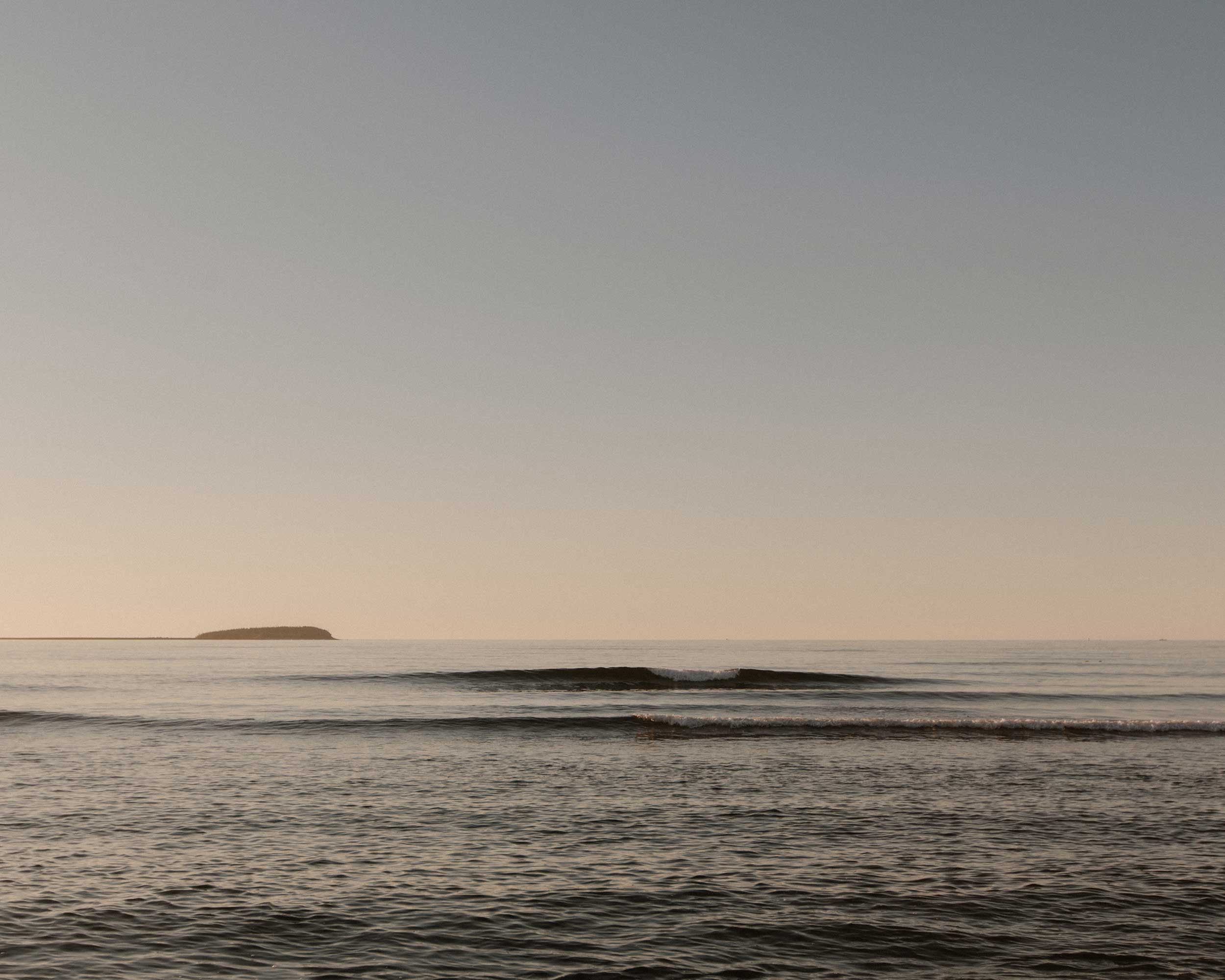
Making a nest by the sea
___
Since we weren’t from the area, we decided to inhabit our new land slowly, and to share it. Ben and Lis, our tenants, live in the house that looks out over Chezzetcook Inlet and the Atlantic Ocean. We can always count on them, and vice versa.
Gabriel and I decided to simplify our way of life and transform the fishing cabin into a tiny house. Standing a few metres from the shore, it seemed the perfect spot to make our nest (even if the access road was impassable for cars and there was no drinking water, electricity, or septic system).
Hello, self-sufficiency! We were about to get a crash course. Transporting a sofa bed by wheelbarrow down a 1,000-foot slope, carrying luggage by hand after nine hours on the road, relieving ourselves in the woods, waiting for rain to wash the dishes, scrubbing ourselves with a face cloth? No problem! The nearness of the ocean and the fires on the shore in good company more than made up for the inconveniences.
At the end of the summer in 2019, we started dreaming of a small extension. It seemed feasible: Gabriel has experience in construction, and I have an eye for design and enjoy manual labour. We never suspected that the construction would take another two years.
Mud up to our knees
___
That fall, Gabriel headed to the land ahead of me to begin work. First we had to widen and consolidate the access road and bring drinking water to the cabin. When I arrived, I hit a wall — or rather, an excavator and a 10-wheel truck. Our pretty, grassy path lined with wild blackberries had been transformed into a massive muddy gulch! Gabriel was standing in the trench unrolling a length of pipe, while Jason, our excavator, followed behind backfilling the ditch. What should have taken a week ended up taking three. Beneath an tempestuous sky, the aggregate layer disappeared into the mud like it was butter. A third of our reno budget had just been swallowed up by a pile of rocks.
Weeks of mud and bad weather is hard on morale. On October 19th, Gabriel’s birthday, it was hailing. Still neither path nor drinking water, and no good surf days either. We finally said, “Fuck it, let’s spend the last week of our vacation in Salvador!” Forty-eight hours later we were surfing in warm waters.
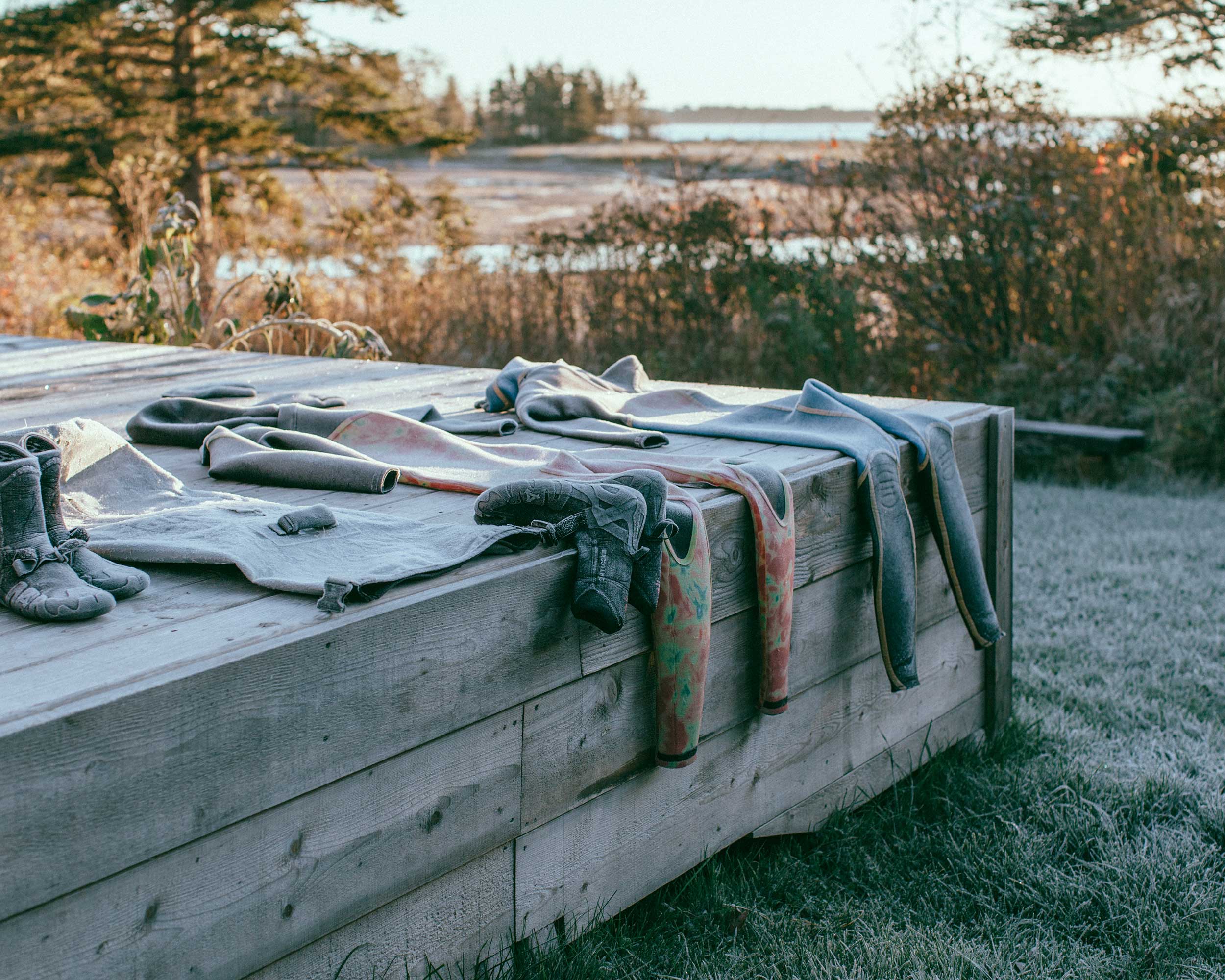
Renovating off-grid, slowly but surely
___
In the winter of 2019, Jason finished building the path. On the frozen ground, the aggregate layer stayed firm. Drinking water was finally connected, outside. This was huge progress, even if we couldn’t always count on having a shower to warm up after surfing in -4 °C weather.
When spring came, after we amended the soil so we could lay a long-awaited bed of greenery, it was time to think about the extension plan. We assessed our needs, then drew the plans on the ground: an entry hall big enough for two drenched surfers, an adjoining bathroom, a large cupboard to hold the surfboards, wetsuits, and tools, a pantry that would also serve as a closet, and a workspace built into the hallway.
By the second summer, in spite of a number of trips back and forth to Québec, the work still wasn’t as far along as we hoped. I have to admit that surfing and days on the beach with friends were something of a distraction. We had to remind ourselves not to lose sight of our original intentions.
Jason built the foundations using oversized foam tubes in order to better attach the existing cabin to the addition, and above all, to ensure its weather resistance. As surfers, we have a love/hate relationship with storms. On one hand, well-oriented storms create the best waves. On the other, they erode the already-fragile coast. Nova Scotia is particularly exposed to the elements and undergoes significant damage from erosion each year. It’s best to be aware of this when buying a property on the coast and plan a budget for protecting and restoring the banks.
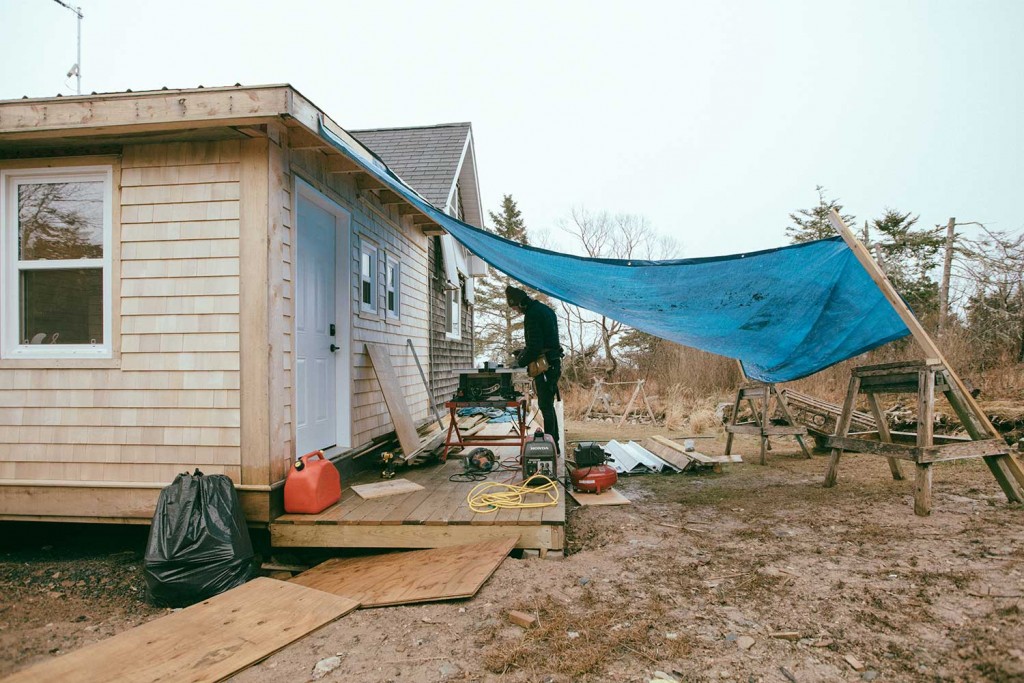
Reinforcement on the port side
___
For our second autumn “vacation” at the cabin, our tenant Ben, a carpenter by trade, came to help us build the frame for the extension. Gabriel’s colleagues Mario and Sébastien gave us a hand with insulation, electricity, plumbing, and the ceramic-tile shower I was so stubbornly set on.
It’s impossible to do renovations, whether large or small, without leaving a trace, environmentally speaking. This is why it’s so important to make conscientious choices beforehand. We tried to use surplus construction materials, including rock wool, pipes for plumbing, and windows that Gabriel’s father had salvaged. Friends even offered their leftover pine planks, which we used to line the interior.
I especially enjoyed placing cedar shingles with the nail gun. It’s almost meditative. With a little practice, you can tap into an instinctual human ability for manual labour.
Understanding how our solar panels work proved a good deal less meditative. Jeremy, the former owner, had installed the system himself with the intention of transforming the cabin into an office. We were lucky to inherit his system — now, we had to learn to reconnect all the wires in the right places, like a game of electricity Tetris!
Between trips to the hardware store, surf sessions, and hammer sessions, the project was seriously taking shape.
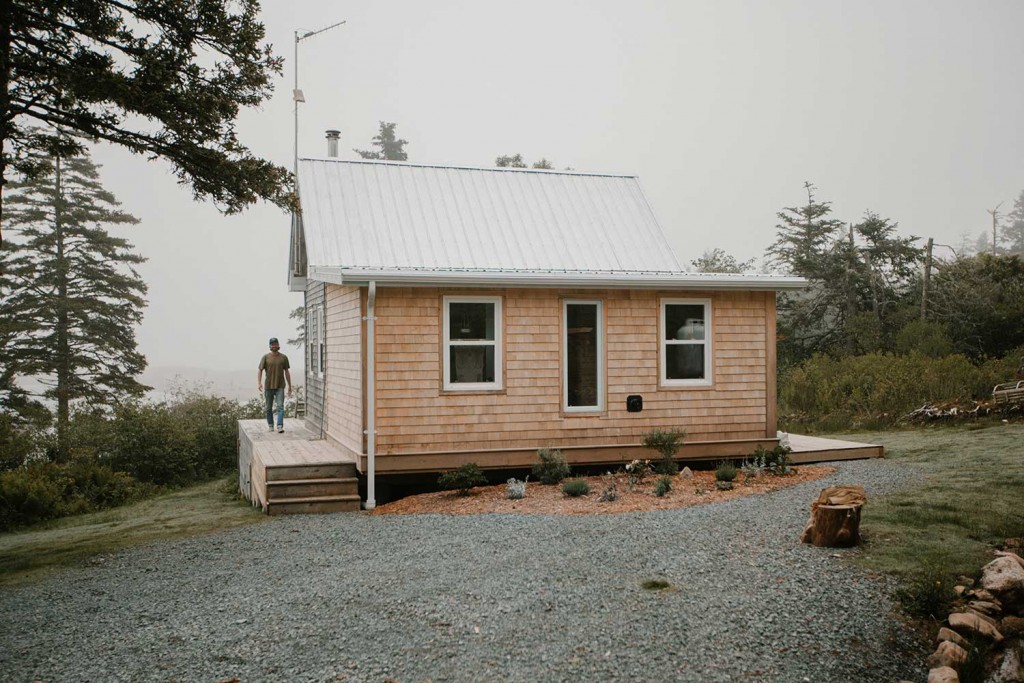
Locked down in our dream of 450 ft2
___
As the reality of lockdown was taking hold, we sold our condo in Québec and decided to move into our tiny house. Gabriel’s company was temporarily closed because of the lockdown, and I was able to work remotely.
The forced pause allowed us to finish the electrical work, the floors, the kitchen cabinets, the filter bed, and to build an outdoor shower. Best of all, we even set up a small kitchen garden: sea buckthorn and roses, two hardy bushes, beside strawberry plants, mint, rosemary, and lavender.
While we waited impatiently for a fridge to arrive (as well as a water heater, a hot plate, and a propane tank), we developed all sorts of strategies to manage energy and avoid wasting food. We put our coolers on the ground, filled them with snow, and emptied them out regularly; planned our menu according to expiry dates; and heated water on the stove for mock-showers. I must admit, there were many moments when I dreamed of a good hot bath.

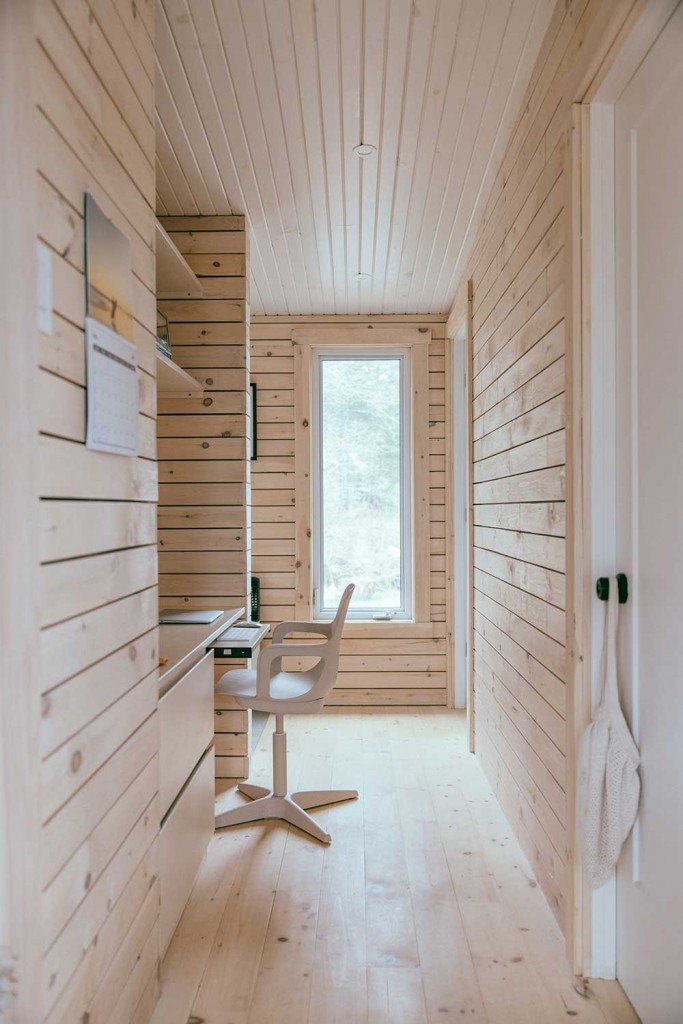
My full-time work required me to be in Zoom meetings for a good part of the day, and the solar energy retention capacity of our old batteries proved insufficient. As the weeks went by, I had to finish my days plugged into the generator. I envied those who had the time — or an oven — to make bread. Candles at dinner had ceased to be romantic; they were simply necessary. I soon recognized that full-time online work didn’t fit well with our back-to-the-land lifestyle. The reality is that everything takes more time and devotion, whether it’s managing the land or providing for one’s basic needs. So I decided to remain faithful to my convictions and to cut back on my work hours in order to appreciate the way of life I had chosen — and also to help Gabriel, who was up to his ears applying water-based whitening varnish to the floors and walls.
In our little refuge, we weren’t immune to anxiety. What would become of the world? The pandemic reminds us that we need to learn — collectively and urgently — to live more lightly on the earth. This realization soothed me. I found some hope within the dark.


In the months that followed, we developed stronger relationships with our neighbours and learned the true meaning of co-operation. We traded evenings at a restaurant for birdwatching, cleaned up the beach, prepared our subsistence crops with our tenants, and built new paths in the woods. We took the time to better understand the functioning of the collective ecosystem of which we were now a part. Now that we had become more anchored on the land, our desire to protect it grew, as if we were protecting a part of ourselves.
We realized the luck we had — not just to own a piece of property, but to live rooted in an environment, close to water and forest, within a supportive community.
***
We just recently made the transition from self-sufficient cabin to “semi-connected” tiny house. Gabriel dug a new trench to connect the fibre optic and electricity. We keep ourselves to 15 amps, but it’s enough (not to plug in a hair dryer, but who cares!). Having lived without so many things for a time, we appreciate our new amenities all the more — even if it’s just being able to surf the web without worrying about draining our solar batteries. It’s a choice that suits our new way of working — we can still continue our professional activities, while also living in an environment that helps replenish our overworked minds.

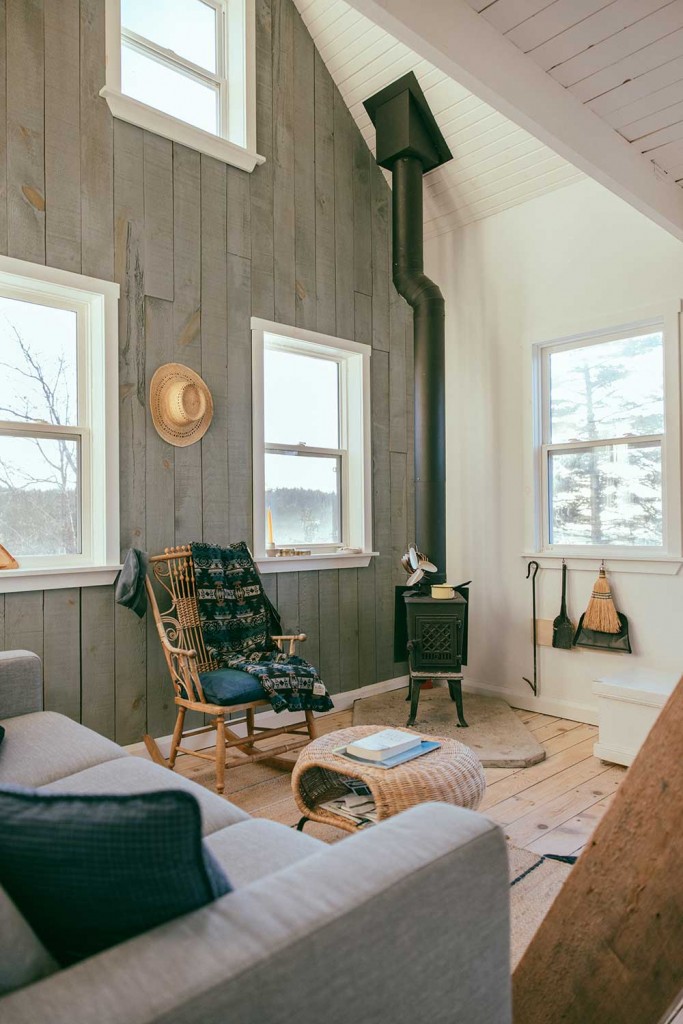

My third spring at the cabin has begun with a convalescence. After suffering a mild concussion while surfing, I have had to slow down. Strangely, in spite of the discomfort that comes along with it — including not being able to practise my favourite sport — this period has given me the chance to really contemplate the mode of life I’ve chosen. Forced to stop, I’ve radically cut back on the number of hours I spend in front of the screen. I’ve been able to put the final touches on the cabin and to spend time gardening. The great heron has returned; I noted this in the calendar. I hear the thrum of the lobster boats coming back to port; I watch the seagulls wooing each other through the sky. The weather is sweet in my little piece of the world. I imagine that this is how my Pépé felt, in his rowboat in Cap-des-Rosiers.
***
A few pieces of advice
___
We are far from being experts, but here are 15 things we’ve learned that could be helpful for others, too:
- Get to know the land. What is the cultural and environmental picture of the place? For example, is there a significant erosion problem? Before planting anything, inform yourself about indigenous and potentially invasive species.
- Introduce yourself to your neighbours, learn their story, and be open to their advice. Many have lived here for generations and have a deep knowledge of the land. They’ve seen their share of weather!
- Choose biodegradable household products and water-based varnishes.
- Don’t hesitate to ask around for surplus construction materials.
- If you have wood fire heating, save construction materials without varnish or glue, sawdust, and the dust from sanding to feed the fire.
- Consider your choices around energy supply. Evaluate sun exposure in the area. Solar panels are not always the best option, particularly in Canada, where hours of sunshine are limited in winter. Batteries need to be changed at least every five years, depending on your energy consumption. If the dwelling is relatively close to a hydroelectric network, it might be a better option to connect to the grid.
- Ideally, spend time living in the place before starting renovations. Once you’re on site, what’s needed will become obvious.
- Gather driftwood to make small hooks, rods, and shelves.
- Plan for lots of storage space, especially if you practise a sport that requires equipment. A space under the porch is ideal for storing equipment.
- Don’t be scared to have hybrid rooms. For example, a closet/pantry.
- From the start, install a compost bucket outside. Use surplus construction material to build it.
- Support local artists, woodworkers, textile artists, and thrift stores in the area. It’s a great way to introduce yourself to a new community, to support the local economy, and to buy objects that are much more durable.
- Get a generator powerful enough for the work that needs doing!
- If the dwelling is hooked up to propane, install a connection for a barbecue instead of using tanks.
- Finally, give yourself lots of time. Renovating can become a real ordeal when you’re in a rush. On the other hand, the adventure can be deeply satisfying when approached with patience!
Freelance writer and photographer Catherine Bernier also holds degrees in counselling psychology and teaching meditation. Originally from Sainte-Flavie, Gaspésie, she cultivates a special relationship with the ocean and the vast wilderness.
Never Miss Another Issue
Two issues per year
25% OFF previous issues
Free Shipping in Canada


